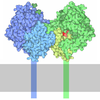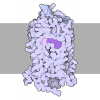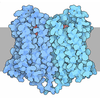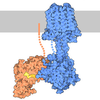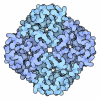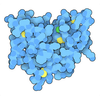+ Open data
Open data
- Basic information
Basic information
| Entry | Database: PDB / ID: 9i52 | ||||||
|---|---|---|---|---|---|---|---|
| Title | Dopamine 1 receptor:GaS complex bound to 19B | ||||||
 Components Components |
| ||||||
 Keywords Keywords | HORMONE / D1R / GS / AGONIST / PARKINSON / NEUROSCIENCE / D1R GS | ||||||
| Function / homology |  Function and homology information Function and homology informationdopamine neurotransmitter receptor activity, coupled via Gs / dopamine neurotransmitter receptor activity / operant conditioning / cerebral cortex GABAergic interneuron migration / Dopamine receptors / dopamine binding / regulation of dopamine uptake involved in synaptic transmission / phospholipase C-activating dopamine receptor signaling pathway / peristalsis / heterotrimeric G-protein binding ...dopamine neurotransmitter receptor activity, coupled via Gs / dopamine neurotransmitter receptor activity / operant conditioning / cerebral cortex GABAergic interneuron migration / Dopamine receptors / dopamine binding / regulation of dopamine uptake involved in synaptic transmission / phospholipase C-activating dopamine receptor signaling pathway / peristalsis / heterotrimeric G-protein binding / modification of postsynaptic structure / G protein-coupled receptor complex / positive regulation of neuron migration / grooming behavior / habituation / regulation of dopamine metabolic process / sensitization / dopamine transport / astrocyte development / dentate gyrus development / striatum development / conditioned taste aversion / positive regulation of potassium ion transport / maternal behavior / arrestin family protein binding / positive regulation of mini excitatory postsynaptic potential / beta2-adrenergic receptor activity / negative regulation of smooth muscle contraction / non-motile cilium / AMPA selective glutamate receptor signaling pathway / positive regulation of autophagosome maturation / norepinephrine-epinephrine-mediated vasodilation involved in regulation of systemic arterial blood pressure / heat generation / norepinephrine binding / long-term synaptic depression / Adrenoceptors / mating behavior / adult walking behavior / positive regulation of lipophagy / negative regulation of multicellular organism growth / negative regulation of G protein-coupled receptor signaling pathway / ciliary membrane / G protein-coupled dopamine receptor signaling pathway / temperature homeostasis / endosome to lysosome transport / response to psychosocial stress / adrenergic receptor signaling pathway / diet induced thermogenesis / D-glucose import / dopamine metabolic process / transmission of nerve impulse / positive regulation of cAMP/PKA signal transduction / adenylate cyclase binding / smooth muscle contraction / PKA activation in glucagon signalling / developmental growth / G-protein alpha-subunit binding / hair follicle placode formation / G protein-coupled receptor signaling pathway, coupled to cyclic nucleotide second messenger / bone resorption / D1 dopamine receptor binding / potassium channel regulator activity / positive regulation of bone mineralization / intracellular transport / neuronal dense core vesicle / prepulse inhibition / positive regulation of synaptic transmission, glutamatergic / brown fat cell differentiation / behavioral fear response / vascular endothelial cell response to laminar fluid shear stress / neuronal action potential / renal water homeostasis / activation of adenylate cyclase activity / Hedgehog 'off' state / intercellular bridge / synapse assembly / adenylate cyclase-activating adrenergic receptor signaling pathway / regulation of sodium ion transport / behavioral response to cocaine / cellular response to glucagon stimulus / presynaptic modulation of chemical synaptic transmission / regulation of insulin secretion / receptor-mediated endocytosis / response to cold / response to amphetamine / adenylate cyclase activator activity / positive regulation of release of sequestered calcium ion into cytosol / trans-Golgi network membrane / synaptic transmission, glutamatergic / negative regulation of inflammatory response to antigenic stimulus / clathrin-coated endocytic vesicle membrane / bone development / G protein-coupled receptor activity / visual learning / GABA-ergic synapse / platelet aggregation / adenylate cyclase-modulating G protein-coupled receptor signaling pathway / memory / cognition / vasodilation Similarity search - Function | ||||||
| Biological species |  Homo sapiens (human) Homo sapiens (human) | ||||||
| Method | ELECTRON MICROSCOPY / single particle reconstruction / cryo EM / Resolution: 2.8 Å | ||||||
 Authors Authors | Clairfeuille, T. / Rodriguez Sarmiento, R.M. | ||||||
| Funding support | 1items
| ||||||
 Citation Citation |  Journal: J Med Chem / Year: 2025 Journal: J Med Chem / Year: 2025Title: Orally Bioavailable Dopamine D1/D5 Receptor-Biased Agonists to Study the Role of β-Arrestin in Treatment-Related Dyskinesia in Parkinson's Disease. Authors: Rosa María Rodríguez Sarmiento / Stefan Berchtold / Nenad Manevski / Lothar Lindemann / Fabian Dey / Thomas Clairfeuille / Davide Amendola / Nicolas Vautrelle / Venceslas Duveau / Eoin C O Connor /   Abstract: Dopamine replacement therapies for Parkinson's disease often produce dyskinesias with long-term use. Published studies suggest that introducing β-arrestin signaling might be protective for ...Dopamine replacement therapies for Parkinson's disease often produce dyskinesias with long-term use. Published studies suggest that introducing β-arrestin signaling might be protective for dyskinesia. We advanced known noncatecholamine D1/D5 receptor G protein-biased agonists and found that removal of oxygen in the linker from published compounds limited β-arrestin recruitment, whereas introduction of nitrogen on the central -phenyl linker favored β-arrestin recruitment and provided orally bioavailable compounds. Cryogenic electron microscopy suggested key receptor-ligand interactions influencing the different bias behaviors. We discovered compound , a D1/D5 receptor agonist with β-arrestin recruitment and properties for use . We compared with tavapadon, which shows weak efficacy for β-arrestin signaling, in a rat model of Parkinson's disease with L-DOPA-induced dyskinesias. At particular doses, compound produced efficacy comparable to L-DOPA, but with fewer concomitant dyskinesias. This first study suggests that β-arrestin may have a positive influence on reducing dyskinesias following acute administration. | ||||||
| History |
|
- Structure visualization
Structure visualization
| Structure viewer | Molecule:  Molmil Molmil Jmol/JSmol Jmol/JSmol |
|---|
- Downloads & links
Downloads & links
- Download
Download
| PDBx/mmCIF format |  9i52.cif.gz 9i52.cif.gz | 206.5 KB | Display |  PDBx/mmCIF format PDBx/mmCIF format |
|---|---|---|---|---|
| PDB format |  pdb9i52.ent.gz pdb9i52.ent.gz | Display |  PDB format PDB format | |
| PDBx/mmJSON format |  9i52.json.gz 9i52.json.gz | Tree view |  PDBx/mmJSON format PDBx/mmJSON format | |
| Others |  Other downloads Other downloads |
-Validation report
| Summary document |  9i52_validation.pdf.gz 9i52_validation.pdf.gz | 1.1 MB | Display |  wwPDB validaton report wwPDB validaton report |
|---|---|---|---|---|
| Full document |  9i52_full_validation.pdf.gz 9i52_full_validation.pdf.gz | 1.1 MB | Display | |
| Data in XML |  9i52_validation.xml.gz 9i52_validation.xml.gz | 39.9 KB | Display | |
| Data in CIF |  9i52_validation.cif.gz 9i52_validation.cif.gz | 59.5 KB | Display | |
| Arichive directory |  https://data.pdbj.org/pub/pdb/validation_reports/i5/9i52 https://data.pdbj.org/pub/pdb/validation_reports/i5/9i52 ftp://data.pdbj.org/pub/pdb/validation_reports/i5/9i52 ftp://data.pdbj.org/pub/pdb/validation_reports/i5/9i52 | HTTPS FTP |
-Related structure data
| Related structure data |  52624MC  9i54C M: map data used to model this data C: citing same article ( |
|---|---|
| Similar structure data | Similarity search - Function & homology  F&H Search F&H Search |
- Links
Links
- Assembly
Assembly
| Deposited unit | 
|
|---|---|
| 1 |
|
- Components
Components
-Protein , 1 types, 1 molecules R
| #1: Protein | Mass: 59074.711 Da / Num. of mol.: 1 Source method: isolated from a genetically manipulated source Source: (gene. exp.)  Homo sapiens (human) / Gene: ADRB2, ADRB2R, B2AR, DRD1 / Cell line (production host): Sf9 / Production host: Homo sapiens (human) / Gene: ADRB2, ADRB2R, B2AR, DRD1 / Cell line (production host): Sf9 / Production host:  |
|---|
-Guanine nucleotide-binding protein ... , 3 types, 3 molecules BGA
| #2: Protein | Mass: 38636.199 Da / Num. of mol.: 1 Source method: isolated from a genetically manipulated source Source: (gene. exp.)  Homo sapiens (human) / Gene: GNB1 / Production host: Homo sapiens (human) / Gene: GNB1 / Production host:  |
|---|---|
| #3: Protein | Mass: 7861.143 Da / Num. of mol.: 1 Source method: isolated from a genetically manipulated source Source: (gene. exp.)  Homo sapiens (human) / Gene: GNG2 / Production host: Homo sapiens (human) / Gene: GNG2 / Production host:  |
| #4: Protein | Mass: 45755.547 Da / Num. of mol.: 1 Source method: isolated from a genetically manipulated source Source: (gene. exp.)  Homo sapiens (human) / Gene: GNAS, GNAS1, GSP / Production host: Homo sapiens (human) / Gene: GNAS, GNAS1, GSP / Production host:  References: UniProt: P63092, Hydrolases; Acting on acid anhydrides; Acting on GTP to facilitate cellular and subcellular movement |
-Non-polymers , 2 types, 3 molecules 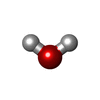
| #5: Chemical | ChemComp-A1IZU / Mass: 346.383 Da / Num. of mol.: 1 / Source method: obtained synthetically / Formula: C20H18N4O2 |
|---|---|
| #6: Water | ChemComp-HOH / |
-Details
| Has ligand of interest | Y |
|---|---|
| Has protein modification | Y |
-Experimental details
-Experiment
| Experiment | Method: ELECTRON MICROSCOPY |
|---|---|
| EM experiment | Aggregation state: PARTICLE / 3D reconstruction method: single particle reconstruction |
- Sample preparation
Sample preparation
| Component | Name: D1R complex with Gas and 19B / Type: COMPLEX / Entity ID: #1-#4 / Source: RECOMBINANT |
|---|---|
| Molecular weight | Experimental value: NO |
| Source (natural) | Organism:  Homo sapiens (human) Homo sapiens (human) |
| Source (recombinant) | Organism:  |
| Buffer solution | pH: 7.5 |
| Specimen | Embedding applied: NO / Shadowing applied: NO / Staining applied: NO / Vitrification applied: YES |
| Specimen support | Grid material: GOLD / Grid mesh size: 300 divisions/in. / Grid type: UltrAuFoil R1.2/1.3 |
| Vitrification | Instrument: LEICA PLUNGER / Cryogen name: ETHANE / Humidity: 95 % / Chamber temperature: 283 K |
- Electron microscopy imaging
Electron microscopy imaging
| Microscopy | Model: JEOL CRYO ARM 300 |
|---|---|
| Electron gun | Electron source:  FIELD EMISSION GUN / Accelerating voltage: 300 kV / Illumination mode: FLOOD BEAM FIELD EMISSION GUN / Accelerating voltage: 300 kV / Illumination mode: FLOOD BEAM |
| Electron lens | Mode: BRIGHT FIELD / Nominal defocus max: 2500 nm / Nominal defocus min: 500 nm |
| Image recording | Electron dose: 40 e/Å2 / Film or detector model: GATAN K3 (6k x 4k) |
- Processing
Processing
| EM software |
| ||||||||||||||||||||||||
|---|---|---|---|---|---|---|---|---|---|---|---|---|---|---|---|---|---|---|---|---|---|---|---|---|---|
| CTF correction | Type: PHASE FLIPPING AND AMPLITUDE CORRECTION | ||||||||||||||||||||||||
| Symmetry | Point symmetry: C1 (asymmetric) | ||||||||||||||||||||||||
| 3D reconstruction | Resolution: 2.8 Å / Resolution method: FSC 0.143 CUT-OFF / Num. of particles: 936735 / Symmetry type: POINT | ||||||||||||||||||||||||
| Refinement | Highest resolution: 2.8 Å Stereochemistry target values: REAL-SPACE (WEIGHTED MAP SUM AT ATOM CENTERS) | ||||||||||||||||||||||||
| Refine LS restraints |
|
 Movie
Movie Controller
Controller




 PDBj
PDBj



